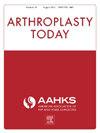Toward Opioid-Free Total Hip Arthroplasty: A Retrospective Study of a Targeted Opioid Reduction Program in 229 Patients
IF 2.1
Q3 ORTHOPEDICS
引用次数: 0
Abstract
Background
Prescription opioids leftover following arthroplasty surgery pose risks to patients and communitys. The purpose of this study was to capture opioid utilization patterns following primary total hip arthroplasty before and after a targeted intervention to decrease postoperative opioid prescription quantity. We hypothesized that reducing discharge pill count would not impact pain or functional outcomes.
Methods
Primary total hip arthroplasties performed by a high-volume, fellowship-trained arthroplasty surgeon between October 2022 and January 2024 were retrospectively evaluated for study inclusion; 229 patients met inclusion criteria. Beginning in April 2023, the surgeon gradually implemented a 38% reduction in postoperative opioid prescribing from 40 to 24 pills. Opioid consumption was evaluated by patient-reported pill count at the first postoperative visit. Patients were sorted into 2 groups: “preintervention” (n = 157) and “postintervention” (poI) (n = 72). Preintervention patients received between 300 and 420 oral morphine equivalents and poI patients received between 240 and 299.99 oral morphine equivalents. Demographics, pill counts, refills, 30-day emergency department visits, function (Hip Disability and Osteoarthritis Outcome Score Joint Replacement), pain (visual analog scale), and satisfaction scores were analyzed.
Results
Proportion of discharge prescription remaining at 2-week postoperative visit did not differ significantly between intervention groups (P = .33). There were no differences in opioid refill requests (P = .82), function (P = .75), or satisfaction with functional improvement (P = .61). Patients in the poI group reported lower pain at 6 weeks postoperatively (P < .05). There were no differences in 30-day emergency department visits between groups (P = .57).
Conclusions
Results support that arthroplasty surgeons can prescribe smaller quantities of opioids without compromising care. Such interventions can help reduce the number of prescription opioids available for misuse and diversion.
无阿片类药物全髋关节置换术:229例患者靶向阿片类药物减少计划的回顾性研究
背景:关节置换术后残留的处方阿片类药物对患者和社区构成风险。本研究的目的是捕捉阿片类药物在首次全髋关节置换术前后的使用模式,以减少术后阿片类药物处方的数量。我们假设减少出院药片数量不会影响疼痛或功能结果。方法回顾性评估2022年10月至2024年1月期间由一名大容量、培训过的关节置换外科医生进行的原发性全髋关节置换术;229例患者符合纳入标准。从2023年4月开始,外科医生逐渐将术后阿片类药物处方从40片减少到24片,减少了38%。通过术后第一次就诊时患者报告的片剂数量来评估阿片类药物的消耗。将患者分为干预前组(157例)和干预后组(72例)。干预前患者口服吗啡当量为300 - 420,poI患者口服吗啡当量为240 - 299.99。分析了人口统计学、药片数量、补药、30天急诊科就诊、功能(髋关节残疾和骨关节炎结局评分关节置换术)、疼痛(视觉模拟量表)和满意度评分。结果两组患者术后2周出院处方保留比例差异无统计学意义(P = 0.33)。两组在阿片类药物补充请求(P = 0.82)、功能(P = 0.75)和功能改善满意度(P = 0.61)方面均无差异。poI组患者术后6周疼痛减轻(P <;. 05)。两组间30天急诊科就诊次数无差异(P = 0.57)。结论结果支持关节置换术医生可以在不影响护理的情况下开少量阿片类药物。此类干预措施有助于减少可用于滥用和转移的处方阿片类药物的数量。
本文章由计算机程序翻译,如有差异,请以英文原文为准。
求助全文
约1分钟内获得全文
求助全文
来源期刊

Arthroplasty Today
Medicine-Surgery
CiteScore
2.90
自引率
0.00%
发文量
258
审稿时长
40 weeks
期刊介绍:
Arthroplasty Today is a companion journal to the Journal of Arthroplasty. The journal Arthroplasty Today brings together the clinical and scientific foundations for joint replacement of the hip and knee in an open-access, online format. Arthroplasty Today solicits manuscripts of the highest quality from all areas of scientific endeavor that relate to joint replacement or the treatment of its complications, including those dealing with patient outcomes, economic and policy issues, prosthetic design, biomechanics, biomaterials, and biologic response to arthroplasty. The journal focuses on case reports. It is the purpose of Arthroplasty Today to present material to practicing orthopaedic surgeons that will keep them abreast of developments in the field, prove useful in the care of patients, and aid in understanding the scientific foundation of this subspecialty area of joint replacement. The international members of the Editorial Board provide a worldwide perspective for the journal''s area of interest. Their participation ensures that each issue of Arthroplasty Today provides the reader with timely, peer-reviewed articles of the highest quality.
 求助内容:
求助内容: 应助结果提醒方式:
应助结果提醒方式:


